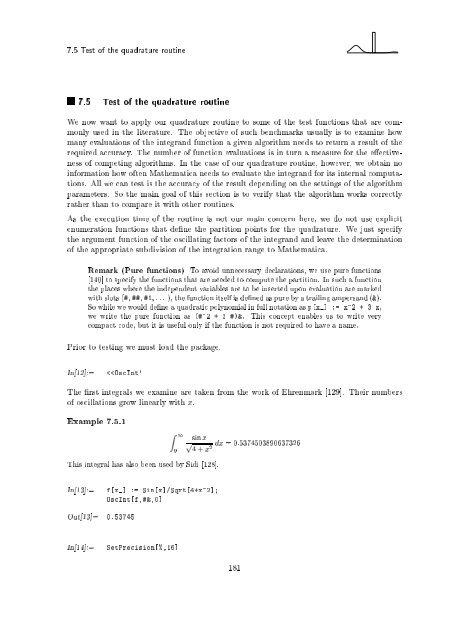Wave Propagation in Linear Media | re-examined
Wave Propagation in Linear Media | re-examined
Wave Propagation in Linear Media | re-examined
Create successful ePaper yourself
Turn your PDF publications into a flip-book with our unique Google optimized e-Paper software.
7.5 Test of the quadratu<strong>re</strong> rout<strong>in</strong>e<br />
7.5 Test of the quadratu<strong>re</strong> rout<strong>in</strong>e<br />
We now want to apply our quadratu<strong>re</strong> rout<strong>in</strong>e to some of the test functions that a<strong>re</strong> commonly<br />
used <strong>in</strong> the literatu<strong>re</strong>. The objective of such benchmarks usually is to exam<strong>in</strong>e how<br />
many evaluations of the <strong>in</strong>tegrand function a given algorithm needs to <strong>re</strong>turn a <strong>re</strong>sult of the<br />
<strong>re</strong>qui<strong>re</strong>d accuracy. The number of function evaluations is <strong>in</strong> turn a measu<strong>re</strong> for the e ectiveness<br />
of compet<strong>in</strong>g algorithms. In the case of our quadratu<strong>re</strong> rout<strong>in</strong>e, however, we obta<strong>in</strong> no<br />
<strong>in</strong>formation how often Mathematica needs to evaluate the <strong>in</strong>tegrand for its <strong>in</strong>ternal computations.<br />
All we can test is the accuracy of the <strong>re</strong>sult depend<strong>in</strong>g on the sett<strong>in</strong>gs of the algorithm<br />
parameters. So the ma<strong>in</strong> goal of this section is to verify that the algorithm works cor<strong>re</strong>ctly<br />
rather than to compa<strong>re</strong> it with other rout<strong>in</strong>es.<br />
As the execution time of the rout<strong>in</strong>e is not our ma<strong>in</strong> concern he<strong>re</strong>, we do not use explicit<br />
enumeration functions that de ne the partition po<strong>in</strong>ts for the quadratu<strong>re</strong>. We just specify<br />
the argument function of the oscillat<strong>in</strong>g factors of the <strong>in</strong>tegrand and leave the determ<strong>in</strong>ation<br />
of the appropriate subdivision of the <strong>in</strong>tegration range to Mathematica.<br />
Remark (Pu<strong>re</strong> functions) To avoid unnecessary declarations, we use pu<strong>re</strong> functions<br />
[140] to specify the functions that a<strong>re</strong> needed to compute the partition. In such a function<br />
the places whe<strong>re</strong> the <strong>in</strong>dependent variables a<strong>re</strong> to be <strong>in</strong>serted upon evaluation a<strong>re</strong> marked<br />
with slots (#, ##, #1, ::: ), the function itself is de ned as pu<strong>re</strong> by a trail<strong>in</strong>g ampersand (&).<br />
So while we would de ne a quadratic polynomial <strong>in</strong> full notation as p[x_] := x^2 + 3 x,<br />
we write the pu<strong>re</strong> function as (#^2 + 3 #)&. This concept enables us to write very<br />
compact code, but it is useful only if the function is not <strong>re</strong>qui<strong>re</strong>d to have a name.<br />
Prior to test<strong>in</strong>g we must load the package.<br />
In[12]:=












